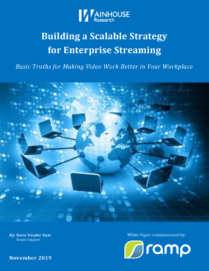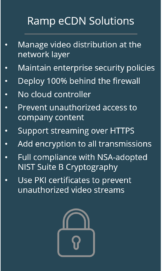Ask any
CIO about what keeps them up at night, and security is at the top of their list.
Security has been a top CIO priority for many years, and it will continue to be
a priority for years to come.
Although the motivation is different from company to company—whether you’re protecting intellectual property or personally identifiable information (PII)—you must secure your systems and information. From networking and applications to data and physical devices, IT security is a broad area of responsibility.
Security is
a basic requirement for enterprise video streaming as well.
“The
benefits of implementing video are nullified if they put an organization at
unnecessary risk,” said Steve Vonder Haar, Wainhouse Research Senior Analyst. “IT
administrators must implement video solutions that both protect corporate
networks and keep unauthorized viewers from accessing protected content.”
Streaming
video solutions must be implemented with security priorities in clear focus. In
this edition of Strategies for Streaming Success, Vonder Haar sheds light on the
topic of security and streaming video.
Risky
Business
Today, most
enterprise streaming solutions are delivered in the “cloud.” Although the list
of benefits for cloud-based solutions is long, you expose your enterprise to a
host of vulnerabilities. So, you need to be diligent when selecting your video
platform. Whether you choose a on-premises or cloud-based solution, it’s risky
business.

In fact, security
is a major consideration for IT execs making streaming purchase decisions. In a
recent survey, Wainhouse Research asked: When your organization considers
future investments in solutions for administering streaming video, how
important will the following factors be in your purchase decision? Sixty-eight
percent responded, “maintaining network security” is “very important.” In
addition, 58% indicated that being able to “distribute video content without
harming the corporate network” is also “very important.”1
This goes
way beyond protecting your video infrastructure. The second you open up your
firewall, you expose your entire network and everything on it to the “bad guys.”
You never want to create any unnecessary vulnerabilities. If an outsider gets
in, they can harm your organization. Not only your business systems and day-to-day
operations, but also your reputation.
And while
network security is critically important, it’s not the only security issue you
need to address. You also want to keep prying eyes away from videos you don’t
want them to see. According to Wainhouse research, 74% of those watching live
online business video daily cite the ability to “secure content from those not
authorized to view” as “very important.”2
Securing
Your Video Network
Now that
we’ve established you’re not alone in wanting (or needing!) to secure every
aspect of your IT environment, let’s talk about some of the questions you
should ask when choosing streaming video solutions.
Is it
secure?
Get to
the heart of the matter up front, and let your vendor tell you about how they
approach the topic of security. It’s important to go beyond what’s built into
their specific solution.
Take time
to learn about their philosophy and how they protect their enterprise. The
latter is especially important if you’re using their hosted solution. If their
take on security isn’t aligned to yours, you probably need to move on.
How does
it authenticate viewers?
Many of
the videos you’re sharing internally are intended for employees only. Whether
it’s an all-hands meeting, executive video message, or employee training, you
need to make sure only your employees can view it. So, you need to authenticate
viewers either by password protecting your videos or via single sign-on.
The
approach you take probably depends on how you handle other sensitive
information within your organization. Single sign-on is the most practical and
easy way for employees to access videos. But password protecting videos can be
extremely helpful if you have workers in the field (i.e. service technicians, tower
climbers, installers).
Regardless,
asking up front will save you a lot of headaches later.
How
does it protect the content?
If
outsiders can access or download your videos or an employee can share them
outside of your organization, your security isn’t up to snuff. Encryption prevents
people who aren’t authorized to view your videos from watching them. This is
incredibly important when the information in your videos is proprietary or
contains sensitive information.
You
should evaluate solutions against your company’s enterprise security policies,
including the level of encryption required, the ability to encrypt video while
at rest and in motion, and the likelihood of introducing or propagating malware
across the internal network.
Can I
control who watches specific videos?
Beyond protecting the video itself, you probably want to manage who in your organization can watch specific videos. Therefore, your streaming platform needs to work with your identity and access management solution or directory systems. This way you can determine who can view specific videos.
For example, you may have a video from your CEO intended for his or her direct reports. If you have the proper rules set up, and your video management system is integrated, you can be sure only the top management in your company can view it.
Ramp’s Approach to Security
100% Behind
the Firewall

First and foremost, Ramp’s enterprise content delivery network (eCDN) is favored by security-conscious IT departments because it deploys 100% on site, behind the firewall. Even our web-based management platform, Altimeter , sits behind the firewall.
Most
other enterprise distribution options use a cloud controller to operate, which
means you have to open a communication path through the firewall for your eCDN
solution to work. Once that communication path exists, the solution has the
ability to extract and compile information about your enterprise network.
Since our eCDN is on premises, you never open any firewall ports for it to work. It doesn’t make any unnecessary calls out to the internet (other than to get your videos from your video platform). We never have access to your network, data or videos. You maintain complete control over your eCDN environment from beginning to end.
Encryption
Ramp takes
securing your streaming video one step further. Our eCDN adds a layer of
security by encrypting your videos as they travel your network.
Multicast+ uses digital signatures to maintain the integrity of the exchange between senders and receivers, and encrypts the receiver disk cache to secure data at the viewing device. In addition, Multicast+ supports HTTPS, using PKI certificates, to prevent transmission of unauthorized video streams.
OmniCache protects data in transit, and at rest with HTTPS encryption and offers full compatibility with NIST Suite B cryptography for data.
Both eCDNs also include a built-in public certificate for companies that want to use HTTPS without obtaining their own certificate.
As a result, you have end-to-end encryption when your videos are in motion and at rest.
Removes Risk
We
already touched on the fact you have complete control of your eCDN environment
because it’s deployed and managed 100% behind your firewall—not somewhere in
the cloud. This inherently reduces your enterprise risk.
In
addition, Ramp’s eCDN doesn’t rely on any other device to deliver video streams
like a peer-to-peer network. Sharing and forwarding data from one device to
another increases the risk of transmitting viruses, spyware and other malware
across your network—especially if you have a bring your own device policy.
Therefore,
Ramp maintains the security policies you’ve put in place to protect against
viruses and data breaches.
Make
Video Work Better in Your Workplace

The role of
video in the workplace is becoming more important every day. It’s no doubt, you’re
looking for ways to make video work better in your workplace. Security is just
one of the building blocks to creating a successful video strategy. Download Wainhouse
Research’s whitepaper “Building a Scalable Strategy for Enterprise Streaming” to
uncover four other basic truths to streaming success.
1 Survey
Insight: Enterprise Video, ITDM Perspectives – North America Q3 2019
2 Building
a Scalable Strategy for Enterprise Streaming
The post Security is Always a Priority appeared first on Ramp .

